
 |
Tea Clipper |
 |
| from TeaAntiques.com | ||
| Edition Forty Eight |
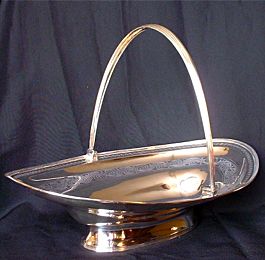
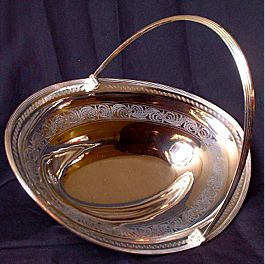
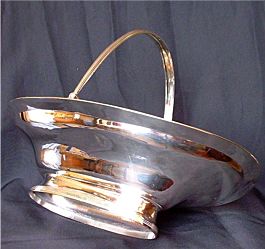
A very elegant George III oval cake (or bread) basket, beautifully engraved with bright cut decoration, this delightful sterling silver basket was made in London in 1800.
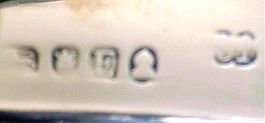
The basket has an oval boat shaped body, with deep oval centre portion. It stands upon an oval raised foot which, like the body, has a reeded rim to it. The basket is hallmarked on the underside of the rim at one side and a short version on the swing handle.
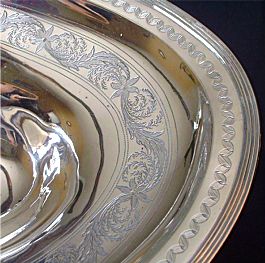 The basket is charmingly decorated inside with beautifully
elegant bright cut decoration, this is contemporary with the basket. There is a
band of double leaf pattern bright cut engraving that runs around the top lip
of the basket.
The basket is charmingly decorated inside with beautifully
elegant bright cut decoration, this is contemporary with the basket. There is a
band of double leaf pattern bright cut engraving that runs around the top lip
of the basket.
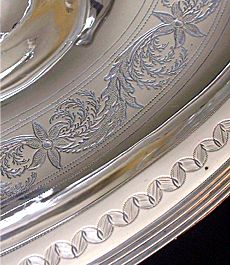 Then, as the basket sides drop away into the centre of the
basket, there is a very broad band of bright cut decoration in the form of a
flower and foliate design. This design comprises large leaves of a plant
such as acanthus, about which are sprays of foliage with very fine branches and
leaves. The pattern is punctuated by flower heads. This decorative floral border
is bounded on both sides with bright cut engraved lines. This is a very
attractive feature of this stunning Georgian cake basket.
Then, as the basket sides drop away into the centre of the
basket, there is a very broad band of bright cut decoration in the form of a
flower and foliate design. This design comprises large leaves of a plant
such as acanthus, about which are sprays of foliage with very fine branches and
leaves. The pattern is punctuated by flower heads. This decorative floral border
is bounded on both sides with bright cut engraved lines. This is a very
attractive feature of this stunning Georgian cake basket.
This delightful cake basket would make a very elegant addition to any afternoon tea table. For this and other fine quality silver items, that are now part of our pre-Christmas silver sale, please see my website where you will find some excellent silver bargains.
More details of this item and other tea related antiques can be found by visiting my website at www.TeaAntiques.com.
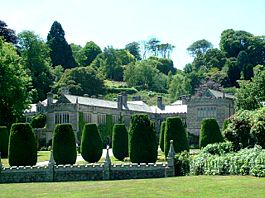 In
the middle of summer, I had the good fortune of visiting a National Trust run
house near Bodmin in Cornwall - Lanhydrock House. A more beautiful setting one
could not imagine, a very fine Victorian House set back against a wooded hill,
with views from the front out over the green rolling country side with a mature
tree-lined avenue sweeping away from the gate house.
In
the middle of summer, I had the good fortune of visiting a National Trust run
house near Bodmin in Cornwall - Lanhydrock House. A more beautiful setting one
could not imagine, a very fine Victorian House set back against a wooded hill,
with views from the front out over the green rolling country side with a mature
tree-lined avenue sweeping away from the gate house.
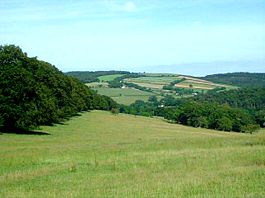 This
house demonstrates beautifully the high life of the Victorian country set as
well as having some extremely interesting and comprehensive suite of servant
domestic rooms. This set of service rooms including a large kitchen, Bake House,
Fish Larder, Meat Larder and Dairy to name but a few. It is these rooms that
allow us to picture the full story of life for the servant as well as the gentry
of the day.
This
house demonstrates beautifully the high life of the Victorian country set as
well as having some extremely interesting and comprehensive suite of servant
domestic rooms. This set of service rooms including a large kitchen, Bake House,
Fish Larder, Meat Larder and Dairy to name but a few. It is these rooms that
allow us to picture the full story of life for the servant as well as the gentry
of the day.
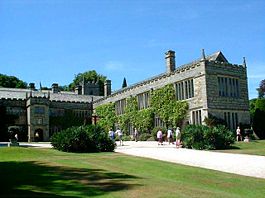 Like
many Victorian houses, Lanhydrock is the site of a much earlier house. The
original house dating from the 17th century still survives in part, this
including the North Wing with its remarkable 32-yard Long Gallery and the
separate turreted gate house set some distance away at the front of the house.
These early parts of the house are the survivors of a tragic fire that destroyed
much of the house in 1881.
Like
many Victorian houses, Lanhydrock is the site of a much earlier house. The
original house dating from the 17th century still survives in part, this
including the North Wing with its remarkable 32-yard Long Gallery and the
separate turreted gate house set some distance away at the front of the house.
These early parts of the house are the survivors of a tragic fire that destroyed
much of the house in 1881.
Following the disastrous fire, the house was rebuild in the latest in Victorian style and ultimate comfort, this included the revolutionary central heating which must have been sheer bliss in a large cold county house.
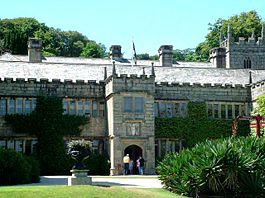 Visiting
the house today, visitors park away from the house up on high ground from which
is a gentle walk down through the park land towards the Gate House. This walk
provides the first beautiful views of the grey walled house and the very formal
and colourful garden set out in front of it. To the right of the house a very
pretty little church.
Visiting
the house today, visitors park away from the house up on high ground from which
is a gentle walk down through the park land towards the Gate House. This walk
provides the first beautiful views of the grey walled house and the very formal
and colourful garden set out in front of it. To the right of the house a very
pretty little church.
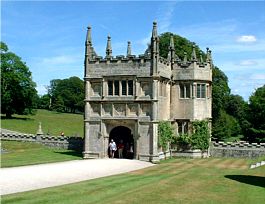 The
Gate House, was built by the original house owner's son, John Robartes in the
1640's. Constructed of local grey granite, it has John's initials carved in the
gate piers. Passing through the Gate House gives a fine view of the house, a 'U'
shape, but once a full quadrangle, the East side was demolished in the 1780's to
open up the view. The gardens in front of the house are laid out in very formal
Victorian style beds and hedges, the beds planted with beautiful English roses
and summer bedding plants of bright and cheerful colours.
The
Gate House, was built by the original house owner's son, John Robartes in the
1640's. Constructed of local grey granite, it has John's initials carved in the
gate piers. Passing through the Gate House gives a fine view of the house, a 'U'
shape, but once a full quadrangle, the East side was demolished in the 1780's to
open up the view. The gardens in front of the house are laid out in very formal
Victorian style beds and hedges, the beds planted with beautiful English roses
and summer bedding plants of bright and cheerful colours.
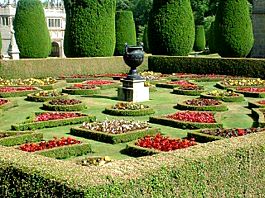
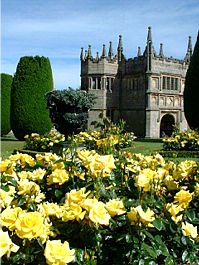
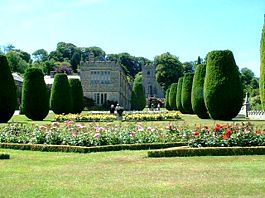
In 1857, the then owner, Thomas Agar-Robartes, later to become 1st Baron Robartes of Lanhydrock and Truro, remodelled the house enlarging it to a more commodious Victorian house. It was this house that sadly after only 14 years was gutted by fire, with little surviving. As with many large country house fires it started in the kitchen and spread through the house from there. Heart-broken by this disaster, Lord and Lady Robartes left it to their son Thomas Agar-Robartes, 2nd Baron Robartes, to rebuild the house. It is this house that Thomas built that confronts us today, built to be as fire proof as possible, using for example, wrought-iron girders instead of wooden rafters. A house designed very much with the Victorian values of segregation, not only of the private and public life of the Baron, but also in the segregation of servants from society members and male and female servants within their own world. Knowing your place and how to behave was of the utmost importance - on both sides.
Like many Cornish wealthy families, their wealth came from the mining of local minerals. Cornwall is rich in tin and china clay deposits. It is this fine china clay that gave us many of the finer porcelains dating back to the Eighteenth century, including Josiah Wedgwood.
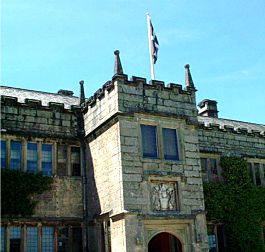 The
house is entered through the turreted front central porch, another survivor of
the fire, which carries a carving above the front door of the families coat of
arms.
The
house is entered through the turreted front central porch, another survivor of
the fire, which carries a carving above the front door of the families coat of
arms.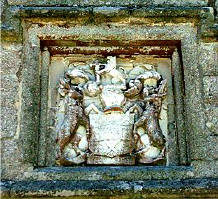 Inside are some remarkable Victorian rooms, some richly decorated and usually,
as with Victorian interiors, rather dark. On the ground floor is the Dining
Room. Here there is a white linen draped dining table, set as if for dinner. It
is typically decorated with central silver ornamentation, sweetmeats and
flowers. The table is bedecked with lines of Ivy in a diaper pattern down its
entire length and with additional garlands draped down the sides. Attention to
decorative detail, a fine tradition of Victorian entertaining.
Inside are some remarkable Victorian rooms, some richly decorated and usually,
as with Victorian interiors, rather dark. On the ground floor is the Dining
Room. Here there is a white linen draped dining table, set as if for dinner. It
is typically decorated with central silver ornamentation, sweetmeats and
flowers. The table is bedecked with lines of Ivy in a diaper pattern down its
entire length and with additional garlands draped down the sides. Attention to
decorative detail, a fine tradition of Victorian entertaining.
There are many rooms to visit, including Lady Robartes's Room; The Billiard Room; His Lordship's Room; The Drawing Room; The Gallery; Morning Room and Music Room to name but a few! However, there is one room in particular, the Boudior, that I would like to talk about, which relates to tea, before concentrating on the servant empire that was necessary to serve such an afternoon tea.
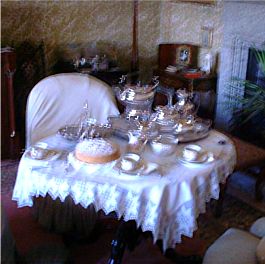 The
Boudior is situated next to Lady Robartes's Bedroom and was very much her domain,
decorated and furnished in a comfortable feminine fashion. On the other side of
this more intimate room is the formal Drawing Room, more of a public
entertaining room. In the Boudoir, it was the perfect place for her Ladyship to
enjoy a delightful fashionable afternoon tea, maybe with a few close friends.
The
Boudior is situated next to Lady Robartes's Bedroom and was very much her domain,
decorated and furnished in a comfortable feminine fashion. On the other side of
this more intimate room is the formal Drawing Room, more of a public
entertaining room. In the Boudoir, it was the perfect place for her Ladyship to
enjoy a delightful fashionable afternoon tea, maybe with a few close friends.
The room is furnished with comfortable tub chairs and a table in the centre, which is laid ready for an afternoon tea. The table is covered with a white lace edged table cloth and set with beautiful Victorian tea silver and porcelain. A silver teaset, together with its spirit tea kettle are there ready and waiting. A silver plated biscuit barrel also sits on the table, this one in the shape of a hand bag with fold down sides, that when closed kept the biscuits fresh and crisp. An array of cakes and sandwiches are ready to be consumed, together with scones and jam etc. But how was this all prepared behind the scenes?
In visiting the servants' part of the house, it was possible to see the effort that went into providing her Ladyship's afternoon tea.
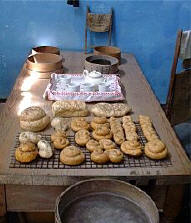 The
Victorian House of 1881 was designed with a block of servant domestic rooms,
each having its own function in the day to day running and feeding of the household. The main focus being the large Kitchen, where the meals would be cooked
for the gentry, but where also, afternoon tea could be prepared. Vast copper
urns would heat the hot water required on coal ranges. Around the back of the
kitchen were many other supporting rooms. There is the Bake House, a most
important room for the preparation of afternoon tea, for it is here that bread,
cakes and scones would be freshly baked. The room has its own baking oven, which
would take several days to come to temperature when first lit, but then would
hold the baking temperature with little more coal being fed into the oven fire.
Below the main baking oven is a separate oven, a cooler oven used to place the
dough in to allow it to rise in the warm before being baked.
The
Victorian House of 1881 was designed with a block of servant domestic rooms,
each having its own function in the day to day running and feeding of the household. The main focus being the large Kitchen, where the meals would be cooked
for the gentry, but where also, afternoon tea could be prepared. Vast copper
urns would heat the hot water required on coal ranges. Around the back of the
kitchen were many other supporting rooms. There is the Bake House, a most
important room for the preparation of afternoon tea, for it is here that bread,
cakes and scones would be freshly baked. The room has its own baking oven, which
would take several days to come to temperature when first lit, but then would
hold the baking temperature with little more coal being fed into the oven fire.
Below the main baking oven is a separate oven, a cooler oven used to place the
dough in to allow it to rise in the warm before being baked.
Having baked the bread, cakes and scones, milk, cream, butter and preserves would be required. For these there are the Dairy Scullery; The Dairy and Still Room respectively.
The Dairy Scullery was the room to which milk was delivered to the house from the farm. Brought in churns, it was then emptied into large white porcelain pans which stood in a long trough, cooled with water. Milk from here could then be used for house hold milk requirements, but more could be used for the production of butter and clotted cream.
For butter production, milk had the cream skimmed off the top and was then allowed to stand for a day before being churned in the wooden butter churn, this painstakingly turned by one of the servants until thick butter was formed.
Clotted cream was made by warming or scolding the milk in large pans and the cream taken off the top. This thick rich cream being the essential part of that oh so delightful afternoon cream tea.
When butter and cream had been made, it would then be stored in the cool Dairy. In the Dairy there is a marble slab which has an ingenious cooling system, comprising cold water running round a channel in the marble top. The central marble table in the dairy is where prepared jellies, blancmanges and other cold desserts would be kept prior to serving - the fore-runner of the modern day refrigerator.
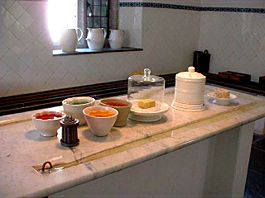
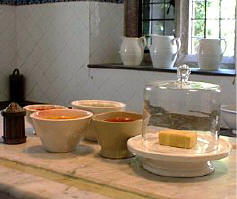
Home-made jams would be taken from the still room - a cool room in which jams, chutneys, etc. would be stored.
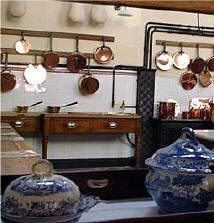 We
now have all the ingredients that are brought together in the kitchen for
the serving of her Ladyship's afternoon tea - that's all you need!
We
now have all the ingredients that are brought together in the kitchen for
the serving of her Ladyship's afternoon tea - that's all you need!
Lanhydrock is a beautiful house that allows us to see both sides of the coin; how the rich Victorian society lived in their country estates and how the servants lived and supported this opulent life-style. It is a house to which I can strongly recommend a visit, but before leaving I do also recommend a visit to the tea room - reviewed below.
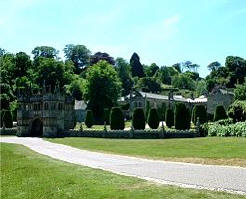
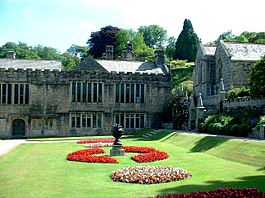
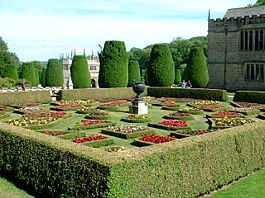
Lanhydrock House
Bodmin
Cornwall
PL30 5AD
Click here for
Local Map
Map courtesy of www.streetmap.co.uk
Having enjoyed a look round the house and gardens of Lanhydrock, I then sampled their afternoon tea in the Servant’s Hall Restaurant. In the past, I have often found National Trust tearooms rather disappointing – but not so at Lanhydrock, which I found an absolute treat.
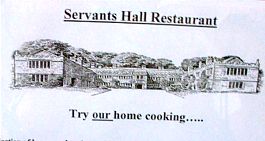
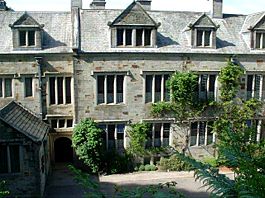 The
tea room is situated in the servants' hall of the house, which has been
beautifully decorated in a cool blue theme with antique Victorian blue and white
transfer printed plates and platters. At one end of the hall hangs an old tavern
clock, which at 3.00PM heralds the start of afternoon teas being served –
following the lunchtime menu.
The
tea room is situated in the servants' hall of the house, which has been
beautifully decorated in a cool blue theme with antique Victorian blue and white
transfer printed plates and platters. At one end of the hall hangs an old tavern
clock, which at 3.00PM heralds the start of afternoon teas being served –
following the lunchtime menu.
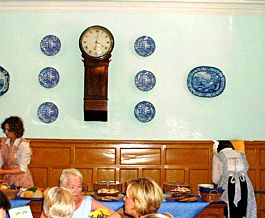 The service and welcome by the well-attired staff, wearing
traditional long pinafores, was very friendly. I was shown to my table and
offered the afternoon tea menu. At the end of the hall beneath the antique wall
clock is a counter on which were displayed the selection of very delicious
looking cakes and biscuits.
The service and welcome by the well-attired staff, wearing
traditional long pinafores, was very friendly. I was shown to my table and
offered the afternoon tea menu. At the end of the hall beneath the antique wall
clock is a counter on which were displayed the selection of very delicious
looking cakes and biscuits.
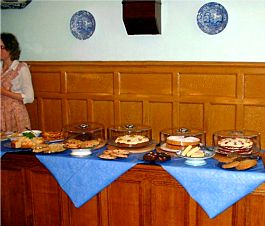
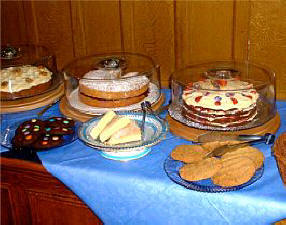
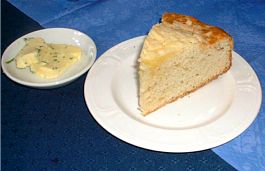
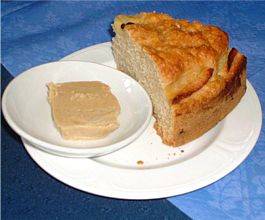 I
was rather spoilt for choice, as the selection and quality looked so tempting.
They offered the traditional cream tea of two homemade scones, with clotted
cream and jam, but also cheese scones with chive butter (above) and apple scones
served with cinnamon butter (left). The difference was that the plain scones
were the usual individual rounds, but the cheese scones and apple scones were
made in a circular tin and then cut into hearty sized wedges. Intrigued by
these, I just had to try the apple scone served with cinnamon butter. Wow, was
it delightful! Like all their cakes, it was homemade and had obviously come
freshly from the oven, as it was still warm, the texture beautifully crumbly
with a crispy crust cooked with sliced apples on top. Thickly spread with the
cinnamon butter the scone was heavenly, one of the nicest and freshest scones I
have had, the flavour of the apple and cinnamon complimenting each other
perfectly.
I
was rather spoilt for choice, as the selection and quality looked so tempting.
They offered the traditional cream tea of two homemade scones, with clotted
cream and jam, but also cheese scones with chive butter (above) and apple scones
served with cinnamon butter (left). The difference was that the plain scones
were the usual individual rounds, but the cheese scones and apple scones were
made in a circular tin and then cut into hearty sized wedges. Intrigued by
these, I just had to try the apple scone served with cinnamon butter. Wow, was
it delightful! Like all their cakes, it was homemade and had obviously come
freshly from the oven, as it was still warm, the texture beautifully crumbly
with a crispy crust cooked with sliced apples on top. Thickly spread with the
cinnamon butter the scone was heavenly, one of the nicest and freshest scones I
have had, the flavour of the apple and cinnamon complimenting each other
perfectly.

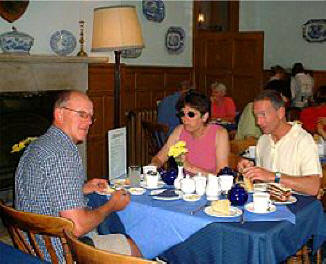
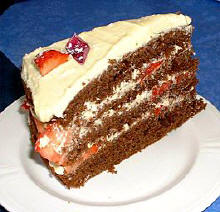 Having
enjoyed the apple and cinnamon scone so much, I just had to try some other of
their fare. I was taken by the look of a strawberry and chocolate cake, looking
very Victorian in its decoration on top with cut strawberries, crystallised
violets and fresh rose petals – a feast for the eyes. Like the scone, this cake
was sublime, four layers of chocolate cake filled between with rich butter cream
and strawberries. Such a cake I am sure would have been the type of cake that
would have been enjoyed by the lady of the house in her boudoir.
Having
enjoyed the apple and cinnamon scone so much, I just had to try some other of
their fare. I was taken by the look of a strawberry and chocolate cake, looking
very Victorian in its decoration on top with cut strawberries, crystallised
violets and fresh rose petals – a feast for the eyes. Like the scone, this cake
was sublime, four layers of chocolate cake filled between with rich butter cream
and strawberries. Such a cake I am sure would have been the type of cake that
would have been enjoyed by the lady of the house in her boudoir.
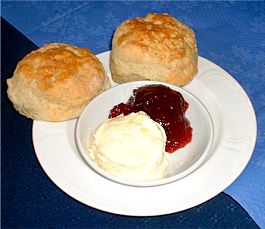 For
those wishing to stick with the traditional cream tea, again, I can certainly
recommend the cream tea served here. The scones were exceptionally fresh, served
warm, the cream wonderful thick Cornish clotted cream and the jam a tasty
strawberry.
For
those wishing to stick with the traditional cream tea, again, I can certainly
recommend the cream tea served here. The scones were exceptionally fresh, served
warm, the cream wonderful thick Cornish clotted cream and the jam a tasty
strawberry.
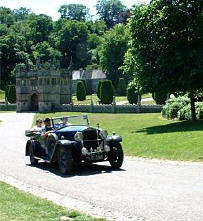 My
only regret is that after eating the scones and chocolate and strawberry cake, I
had no more room to sample some of the other cakes on offer. However, I hope to
visit this magnificent house and tearoom again and as such have the choice of
cakes to look forward to again in the future – I cannot wait!
My
only regret is that after eating the scones and chocolate and strawberry cake, I
had no more room to sample some of the other cakes on offer. However, I hope to
visit this magnificent house and tearoom again and as such have the choice of
cakes to look forward to again in the future – I cannot wait!
For those like myself, who perhaps over indulged on the cakes, a vintage style car is available at a small fee to take you from outside the Gate House, back up the hill to the car park. The perfect end to a perfect day.
To review past newsletters, just follow this link:
Past newsletters.
To subscribe to this free newsletter -
Click here